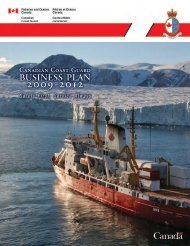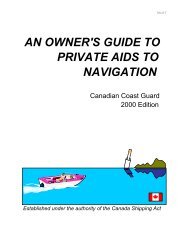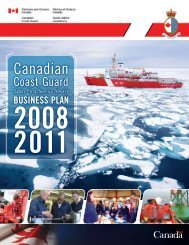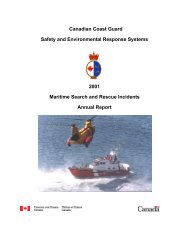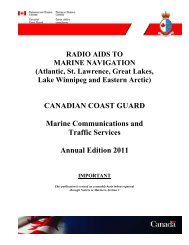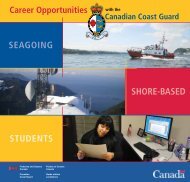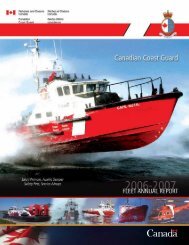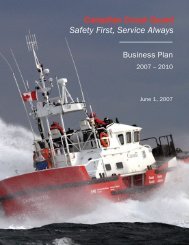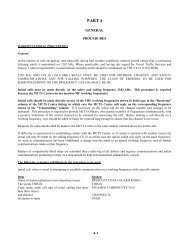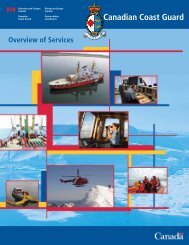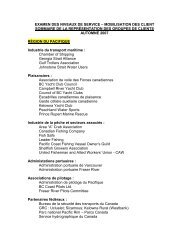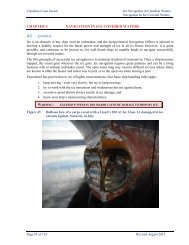RADIO AIDS TO MARINE NAVIGATION - Canadian Coast Guard
RADIO AIDS TO MARINE NAVIGATION - Canadian Coast Guard
RADIO AIDS TO MARINE NAVIGATION - Canadian Coast Guard
You also want an ePaper? Increase the reach of your titles
YUMPU automatically turns print PDFs into web optimized ePapers that Google loves.
Loran-C chart), these errors are minimal and the system should be accurate to within 1/4 nautical mile. This is because<br />
the Loran-C lattice on a nautical chart has already been adjusted to allow for the signal variation as it travels over land.<br />
It is recommended that mariners’ using the latitude/longitude feature of their receiver check the manufacturer’s operating<br />
manual to determine if corrections are necessary and how they may be applied to compensate for overland paths in order<br />
to obtain a greater fix accuracy. The correction can be applied in either of two forms: (i) insertion of a correction when<br />
the vessel is at a known location, or (ii) the insertion of a correction factor that is determined from a table or chartlet. The<br />
latter is called an Additional Secondary Phase Factor (ASF) correction, and the chartlets in Figure 4 can be used to<br />
ascertain the numeric value to apply. These corrections will normally be valid only within 50 to 100 miles of the location<br />
at which the correction was inserted because of the changing effects of land mass on the Loran signals in the different<br />
areas.<br />
E. Cautionary Note – Fishing Near the British Columbia - Alaska <strong>Coast</strong>al Boundary<br />
<strong>Canadian</strong> fishermen using the Loran-C system for navigation must exercise caution when operating the near “A-B” Line,<br />
the coastal boundary in the waters separating B.C. and Alaska.<br />
You should be particularly aware of the signal phase problem discussed in Section D. A receiver being used in the<br />
latitude/longitude mode can experience errors of up to several miles if ASF corrections have not been applied. In some<br />
receivers the corrections are applied automatically within the receiver, while in others the corrections must be applied<br />
manually, be it while located at a known spot or by the addition of ASF corrections.<br />
Note that some of the ASF corrections shown in this publication stop short of the A-B line, and caution must be exercised<br />
when operating in this area.<br />
F. Waypoint Navigation Cautionary Note<br />
Mariners are cautioned that an error can exist between the waypoint navigation information provided by their Loran-C<br />
receiver and the desired straight-line track plotted on a chart. A straight line course plotted between two waypoints on a<br />
mercator chart is a rhumb line, defined as a line on the earth’s surface cutting the meridians of longitude at the same<br />
angle. The course and distances displayed by a microprocessor-based Loran-C receiver, used in the waypoint mode, are<br />
normally computed for a great circle track, not a rhumb line. In the northern hemisphere, a great circle track between two<br />
waypoints lies to the north of a rhumb line joining those same waypoints.<br />
This offset distance, or error, is a maximum when sailing East-West at a latitude of approximately 45 degrees, decreasing<br />
to zero at the equator and at the North and South Poles. It also decreases to zero as your track becomes North-South,<br />
regardless of the latitude. As an example of the offset error possible, a journey from St. John’s, Newfoundland, to the<br />
Lands End area, England, a distance of roughly 1850 nm, would have a maximum offset of approximately 140 nm when<br />
comparing a rhumb line and a great circle track between the two places. The rhumb line versus great circle path offset<br />
becomes a danger only if the mariner has not laid off a great circle course on a Gnomonic chart, ensuring the vessel will<br />
pass clear of all navigational dangers.<br />
G. Loran-C System Status Information<br />
Up-to-date Loran-C status information is available by telephoning:<br />
Loran-C Chain/Rate<br />
Phone Number<br />
West <strong>Coast</strong> U.S./9940 707-765-7518/98<br />
<strong>Canadian</strong> West <strong>Coast</strong>/5990<br />
709-454-3129 Control/Monitor for <strong>Canadian</strong> Loran-C Operations<br />
Gulf of Alaska/7960 707-765-7426/21<br />
North Central U.S./8290 707-765-7518/98<br />
6-2



